We are both pleased and honoured to welcome Geoff Stray as March 2010 Author of the Month at grahamhancock.com. We hope his insights into the meaning and reality of 2012 spur discussion and understanding for those who explore his evidence and theories.
Geoff Stray has been studying the meaning of the year 2012 for over 25 years. In 2000 he summarised his findings on his website, "Diagnosis 2012", attracting international input and it still remains the largest data-base on 2012. Geoff is the author of Beyond 2012: Catastrophe or Ecstasy, published in the UK in 2005, in the United States in 2009 as Beyond 2012: Catastrophe or Awakening. The book is an overview of visions, calendars, prophecies and theories about 2012, and has been called "The Encyclopedia of 2012". He is also the author of The Mayan and Other Ancient Calendars, (2007) and 2012 In Your Pocket (2009) and has written articles for various magazines including HERA, Salvia Divinorum magazine, Caduceus, and New Dawn, and has contributed an essay to the best-selling book, The Mystery of 2012. Geoff has given talks in the UK, Europe, North and South America and Scandinavia and has appeared in documentaries such as 2012:The Odyssey; Timewave 2013; 2012 An Awakening; 2012-Mayan Prophesy and The Shift of the Ages. He lives in Glastonbury, UK, where he also makes handmade footwear.
Website: www.diagnosis2012.co.uk
THE TORTUGUERO PROPHECY UNRAVELLED
Before 2006, many anthropologists, archaeologists and other Maya scholars stated that there was nothing in the Maya inscriptions about the end of the current 5,125-year era of the Long Count calendar. They often did this as part of a dismissal of the increasing discussion about 2012. But in April 2006, epigrapher Dave Stuart answered an enquiry on a specialist discussion group announcing that there is one known inscription from the Classic era that mentions the end of the thirteenth baktun. [1] It is on Monument 6 from a little-known site called Tortuguero, in the state of Tabasco in Mexico. Many maps don't even show the site, or vary in their positioning of it.
Tortuguero was discovered in the 1915, but in 1978 and 1980, Prof. Dr Berthold Riese published studies on the inscriptions found there. The papers are in German. Since then, very little emerged until Sven Gronemeyer's master thesis of 2004 – also in German. [2], [3] An updated version was published in English in 2006. [4] A cement factory was built on top of the site in 1981, but a few ruins remain.
TORTUGUERO MONUMENT 6
Tortuguero's most famous artefact is the Tortuguero Box – a well-preserved carved wooden box inscribed with glyphs that describe, amongst other things, the burial of the Tortuguero ruler, Bahlam Ajaw (Lord Jaguar). Monument 6 is broken into seven parts, four of which are in the Villahermosa museum, not far from the Tortuguero site. Another part is in the Metropolitan Museum of New York, and two other fragments are thought to be in the hands of a private collector. The monument was originally a T-shaped stela, and one of the wings – the left one that starts the narrative – is missing. It is the other wing – the final part of the narrative – that refers to the end of the thirteenth baktun.
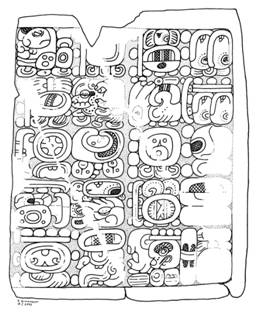
The right wing of Monument 6 from Tortuguero, which refers to the end of the 13th baktun. Drawing by Sven Gronemeyer.
Gronemeyer has split the translation of the monument into six sections. The first section concerns the birth and enthronement of Bahlam Ajaw; the second section concerns "star wars" (wars that were timed by the first appearance of Venus as evening or morning star), and decapitation of prisoners; the third section describes the war against a neighbouring town – Comalcalco and the consequent "harvest of white-flower souls". The fourth section describes unknown events, since some of the glyphs are damaged. The fifth section describes the ritual burning of a house, the setting up of images of Bahlam Ajaw, and a ruler-binding ritual.
This is the context of the final section that commences three glyphs before the right hand side wing and continues through the wing. I have rendered Gronemeyer's translation of this section into English:
7 days 7 Uinals 0 Tuns and 8 Katuns, previously it happened. On 8 Chuen 9 Mak, it was completed for re-birthing*, the pibnaah of Ahkal K'uk. It was 2 days, 9 Uinals, 3 Tuns, 8 Katuns and 3 Baktuns before the 13th Baktun is completed on 4 Ahau 3 Kankin. Then it will happen – darkness, and Bolon-Yokte will descend to the (???)
*nascent becoming
The monument was set up in 669 AD to commemorate a building known as a pibnaah that was built around 160 years earlier in 510 AD. A pibnaah is often translated as a steam bath or sweathouse and this is how Gronemeyer has translated it. The construction of the pibnaah is directly forward-referenced to the end of the 13-baktun era in 2012 with its predicted event – darkness accompanied by the descent of the god Bolon-Yokte, but the prophecy cannot be completed due to damage to the glyphs.
The first question this prompts is, "Who is Bolon-Yokte?" [5] Bolon Yokte is the God of Nine Strides, (or the God of Numerous Strides, since Bolon, which means "nine" is often used as "many"). Sometimes referred to as B'olon Yookte' K'u, or B'olon Okte' K'uh, where K'uh means deity, he has also been called Ah Bolon Yocte of Nine Paths in the post-conquest books of Chilam Balam. The god has an association with the underworld, conflict and war, [6] dangerous transition times, social unrest, eclipses and natural disasters like Earthquakes. He appears at the end of baktuns, assisted at the Creation of the current world and will be present at the next Creation in 2012. Other translations of the name are God of Nine Steps; the Nine-Footed God; and Jaguar-Foot-Tree, because the word bolon or balan (nine) was used by the Maya as a pun for balam (jaguar). The god was seen alternatively as nine individuals or as a collective god.
THE PIBNAAH AND THE KIVA
There are at least 2 examples of a steamhouse-pibnaah at Chichen Itza. Steamhouses are still used by the Maya today and are called "tuj", or sometimes "chitin", or "kun" (oven). The Aztecs also used a steambath called a temazcal – in Mexican package holidays, a spell in a temazcal is often included. They were used for ritual purification ceremonies, healing, revitalization, cleansing, and general meetings. It is known today that they are very beneficial to the health. They flush toxic metals from the system a hundred times faster than the kidneys; they open clogged pores, removing excess salts; they eliminate uric and lactic acid; they increase blood flow, unclog the respiratory tract, and increase negative ions.
Although today's temazcals are above ground, they, and the pibnaahs at Chichen Itza were usually dug five feet into the ground and used a direct fire rather than hot rocks, similar to the method used by Native Americans in California. The design and alignment was similar to that of a Hopi kiva, or underground ceremonial room. Though today's kivas are often above ground and square, the ancient Anasazi, (ancestors of the Hopi) examples are round and mostly below ground. According to Frank Waters's Book of the Hopi, many Hopi regard Aztecs and Maya as "renegade Hopi clans" that did not finish their migrations, so we may have here an insight into the pibnaah.
Native American sweat lodges, as well as kivas are seen as symbolic wombs of the Earth Mother, and not only do the Hopi conduct Creation myth re-enactment ceremonies in kivas, but some tribes design sweat lodges to reflect Creation myths. Not only are Temazcals used for pregnancy and birth, but those who have used them ritually, describe feeling their spirit bodies, acknowledging the four elements, and experiencing the "rebirth and death of parts of the ego that no longer serve growth."
Amazingly, there is an association between kivas and the number nine – perhaps a remnant of the Bolon Yokte connection, upon which we are seeking to throw light. Every year there are nine major ceremonies traditionally performed in the kiva. They correspond to the nine universes of the Hopi Creation myth. There is one universe for the Creator, Taiowa, one for his nephew, Sótuknang, and seven for created life. The Hopi say there are a total of seven Worlds, or eras, and that each one is governed by a psychic centre – the same as the top five chakras of the Hindu system. We are in the Fourth World, known as "World Complete". Our consciousness descended from the crown chakra in the first era down as far as the solar plexus in the current era – each era becoming more materialistic than the last – but at the next World era transition, it will start to reverse direction. Each transition is called an Emergence, and symbolised by a labyrinth symbol – identical the Cretan labyrinth symbol. It is also known as the Mother Earth symbol, or Mother and Child, and the process is seen as a kind of birth process.
There are also said to be nine prophecies that will be fulfilled before the Day of Purification that precedes the Emergence. These are the coming of the white man; covered wagons; longhorn cattle; railroad tracks; power lines & telephone lines; concrete roads; oil spills; the coming of the hippies; the Blue Star kachina. Only the last of these nine remains to be fulfilled. When a blue star is seen in the sky, and the Blue Star kachina dancer removes his mask in the plaza, then the Hopi ceremonies will cease. Though some have said this was Comet Holmes, the fact is that the Hopi ceremonies were still continuing after Comet Holmes came and went (according to eye-witness report of a personal friend).
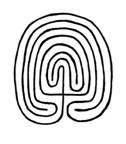
This Mother and Child symbol is identical to the Cretan labyrinth symbol and symbolises a spiritual rebirth from one world to the next. There is also a square version.
NINE GERMINATION RITES
The first of the nine ceremonies is called Wúwuchim, which represents birth. This ceremony is a re-enactment of the Hopi Emergence – their ascent from the third world, represented by the inside of the kiva, to the current Fourth World, into which they emerge at the height of the ceremony, naked and wet like newborns coming out of the womb. They then have their hair washed in nine bowls of yucca suds. This ceremony reaches its height when the Pleiades are overhead at midnight, when the newborns get the signal to "emerge." From John Major Jenkins' discoveries, we know that the Toltec method of tracking precession also involved watching for the Pleiades overhead at midnight. In this way, they could calculate how close they would be to the zenith sun exactly six months later. According to Jenkins, this was encoded into the pyramid of Kukulcan at Chichen Itza, which encodes this 360-year-long Sun-Pleiades conjunction, that starts with a solar eclipse conjunct the Pleiades in the zenith on May 20, 2012.
The second of the nine ceremonies is called Soyál and concerns seed germination. The seeds of their sacred crop, corn (maize), plus other crops such as beans and squash are taken into the kiva and germinated, with the help of the kachinas or nature spirits, who are manifested in the form of dancers. This is followed by Powamu, which is a ceremony based around planting and sprouting. The first of the next group of three ceremonies is Niman Kachina, which concerns growth and maturing. Then comes the Flute Ceremony, about irrigation and more planting, followed by the Snake-Antelope Ceremony that governs fruition. The last three are Lakón, about fertility and planting and harvesting, then Márawu, which concerns flirtation and food gifts, and finally, Owaqlt, which governs conception and gifts. In each group, there is one ceremony that includes an Emergence ceremony. The ceremonies actually work on three levels. – plant, human and species. They not only help seed germination via crop fertility rituals, they also affect human fertility and involve birth rituals, but on a species level, via the Emergence rituals, they perform a re-run and purification – a preparation for the Emergence or birth into the next World – the Fifth.
A further insight is allowed by Dave Stuart's second and more complete translation [7] of the final section of Monument 6:
7 days, 7 Uinals, 0 Tuns and 8 Katuns previously it happened, on the day 8 Chuen, the 9th of Mak, the Becoming-Ripe-House was constructed(?). It was the 'underground house' (shrine) of (the god?) Ahkal K'uk'. It was two and nine-score days, three years, eight-score years and 3 x 400 years (before) the Thriteenth Pik will end on Four Ajaw, the third of Uniiw, when ..(?)… will happen, the descent(?).. of B'olon Yookte' to the ..?
So here, Stuart is providing more information about the pibnaah – it is an underground house or shrine, and also a "Becoming-Ripe House". At Palenque, which is not far from Tortuguero, the three shrines known as the Temple of the Cross, the Temple of the Foliated Cross, and the Temple of the Sun are fairly intact, and in their inscriptions, they are called pibnaahs and associated with Bolon Yokte. [8] Each shrine at the top of a pyramid represents a cave in a mountain – an entrance to Xibalba, the Maya underworld – each a path to be taken by the King, Kihnich Kan B'ahlam II, (son of Lord Pacal). The Temple of the Sun is the shrine to the Jaguar God (remember Jaguar is a pun for nine), and rites of passage are described, in which the King was "Okte'-ed" at the age of six, and a month before his eighth birthday, on the half-katun date of 9.10.10.0.0, he "descended into Okte'ship." The Temple of the Cross is the shrine to the Maize God, and depicts the King undergoing a rite of passage at the age of 13, in which he was "tied into Okte'-ship" and received Bolon Okte'. He is shown as a boy wearing a nine-knotted costume. God L, the cigar-smoking Lord of the Underworld is also shown. At 18, there was another rite of passage, in which the King received the K'awill sceptre. The Temple of the Foliated Cross shows the World Tree as a Maize plant, with corncobs as human heads. The shrine is dedicated to the God Kawil, also known as Bolon Tzacab, the God of Nine Generations, and records the accession to the Throne of the King, at the age of 48.
So we have seen that the pibnaah, as well as a steambath, was a shrine associated with Bolon Yokte, plus the jaguar God and K'awill, both of which also have associations with the number nine. We have also seen that the rituals performed inside were rites of passage including trips to the underworld and the symbolism of maize. The "becoming-ripe" house was actually a shrine for personal evolutionary development, that has parallels to the kiva with its ceremonies of plant development, human development and species evolution at the transition between eras. This may throw some light on the connection between Monument 6 and the pibnaah at Tortuguero.
According to Frank Waters in The Book of The Hopi (1963), the Hopi saw corn as "a living entity with a body similar to man's in many respects". Mother Earth also had an aspect as Corn Mother, and when a child was born, (s)he was kept in the dark for 30 days with his/her "Corn Mother" beside him/her (in the form of an ear of perfect corn whose tip ends in four kernels), and various rituals were performed involving cornmeal. In a similar way, in the Maya myth, The Popol Vuh, a series of Creations are described in which humans evolve – in the first Creation were mud people, then there were wooden doll people, who were replaced by monkey-people. At the start of the current Creation, (which is seen as the fourth or fifth by different commentators), Quetzal Snake and companions grind and mould the maize and form the next race of people – the maize people – who are the ancestors of the Quiche Maya. This includes the ninefold blessing of Xmucane, goddess of midwives. According to Martin Prechtel, in the still-surviving mythology of the Tzutujil Maya, who live in villages surrounding Lake Atitlan in Guatemala, we are in the fifth Creation, which is called Earth Fruit World. As we go through the five stages of life, we assimilate the lessons of five Creations, and then at death, we go to the sixth Creation.
This relationship between humanity and maize is reflected in the sacred Tzolkin calendar. The anthropological evidence provided by Barbara Tedlock in Time and the Highland Maya (1982) indicates that the Tzolkin's 260 days are based on the period of human gestation. When a woman misses her period, there are 260 days until the birth is due. But a 260-day cycle could also be seen as a gestation-period of the maize plant. In the highlands of Guatemala, there are 260 days between planting and harvesting of maize.
There may be a connection with the results found by John Burke in his study of ancient sites, Seed of Knowledge, Stone of Plenty (2005), particularly Neolithic dolmens, Silbury Hill and Avebury, plus vision-quest sites and stone chambers in North America, and the Pyramids at Tikal. Burke and his co-author, Kaj Halberg, found that in all these cases (at Tikal, it was just at the summit of Lost World Pyramid, and not the later Temple 1 and 2), the sites are positioned on a "conductivity discontinuity" that amplifies Earth currents, and the structure amplifies them even more, particularly just before dawn. The result is a two- to-threefold (even more at the Lost-World Pyramid) increase in seed germination that can result after just 20 minutes exposure. These same electro-magnetic fluctuations can affect human consciousness, and the sacred sites, the authors conclude, thus had a secondary use -the alteration of consciousness.
NEW DEVELOPMENTS
There have been some important developments in Maya studies in the past three years that have great significance for the interpretation of Tortuguero Monument 6 and the 2012 Creation point. The first of these is Michael Grofe's 2007 dissertation, The Serpent Series: Precession in the Maya Dresden Codex. [9] Grofe found a 15,000-year+ interval depicted in the Serpent Series of the Dresden Codex that is an almost exact multiple of the sidereal year. This is strong evidence that the Maya were measuring and recording the cycle we know as the precession of the equinoxes.
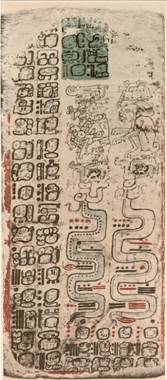
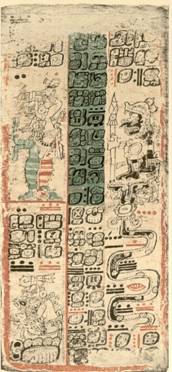
The Serpent Series in the Dresden Codex that show a multiple of the sidereal year, according to Grofe, The dates are read vertically between the coils of the snakes.
In the following year, 2008, Barb Macleod announced the discovery of the "3-11-Pik formula". [10] In analysing the glyphs on a bone from Tikal, she found three intervals of 8,660 days that add to one degree of precession, accompanied by a mirrored period of 3 x 11 baktuns, which is half a precessional period.
In 2009, on Tribe 2012, one of the web's most popular 2012 discussion groups, I started a thread about a forthcoming Mayanist conference on 2012, [11] and in the ensuing discussion, while researching a response, I stumbled across Sven Gronemeyer's 2004 thesis on Tortuguero – a document that I had previously thought was only available in an elusive hardcopy version. I made the links available in one of my posts, and John Major Jenkins then downloaded the thesis, and enlisted the help of Michael Grofe and Barbara Macleod in translating the Monument 6 text directly from the Maya glyphs into English.
This has led to some important new discoveries as Jenkins has just revealed in his The 2012 Story, which is hot off the press. [12] Grofe discovered that on Bahlam Ajaw's birth-date, the Sun was in the exact same position that it will be at the end of the 13th baktun on 21 December 2012 (except that in 2012 precession will have moved the Sun/galactic equator conjunction to the day of winter solstice). Grofe thinks Bahlam Ajaw was claiming a special relationship with the end of the current 13-baktun cycle, and the deity Bolon Yokte, who is connected to that event. Jenkins has also suggested the possibility that Lord Pacal of Palanque did something similar, possibly inspired by Baham Ajaw, and trying to upstage him by having his coronation day on the same day in the solar year as the last day in the next higher cycle in the Long Count – the 20-baktun cycle, or Pictun, thus becoming a kind of higher-ranking time-lord. Jenkins has suggested in his excellent new book, [12] that the king of Copan, 18 Rabbit also connected himself to a future baktun-ending, as well as the katun ending 9.14.0.0.0 when the sun was again in the dark rift. This is also the last date recorded at Tortuguero before 13.0.0.0.0 when Bolon Yokte descends.
Grofe has also discovered that Tortuguero Monument 6 shows evidence that the Maya were measuring precession by recording a lunar eclipse that occurred in the dark rift, when the glare of the Moon would have been negated by the Earth's shadow cast upon it, and allowing the Milky Way shape to be discerned. They were thus able to calculate the date six months later, when the Sun would be in the dark rift. This collaboration between Jenkins, Grofe and Macleod is continuing to provide more evidence that Jenkins's Galactic Alignment theory is based in fact.
Jenkins's theory, as many readers will know, suggests that the Maya deliberately targeted the end-date of their 13-baktun cycle on the winter solstice of 2012, since they viewed it as the point when the solar god One Hunahpu will be reborn in the mouth of the caiman, or sometimes, the jaguar-toad or a snake, represented astronomically by the winter solstice Sun appearing to be in the dark rift in the central bulge of the Milky Way. The convergence of the winter solstice sun with the dark rift is governed by what we call the precession of the equinoxes, caused by the slow wobble of Earth's tilt over approximately 26,000 years. The Maya were measuring this movement by the Sun's winter solstice position, rather than the spring equinox. Jenkins found constant references to this as a birth event, where the sun is reborn from the birth canal of the Great Mother, and we have seen that the sweat lodges and kivas were symbolic wombs of the Earth mother, and the kivas were used for symbolic rebirth rituals that see the forthcoming Emergence as a birth.
In 2009, Michael Grofe published an essay called, The Name of God L: B'olon Yokte' K'uh? [13] in which he pointed out that the right sanctuary panel from the Temple of the Cross at Palenque (one of the pibnaahs), shows an image of God L, the cigar-smoking Lord of the Underworld, in which he carries the "skeletal centipede", and that on it are clearly shown nine footprints. He concludes that God L and Bolon Yokte (the God of Nine Steps) could be the same deity, and that Bolon Yokte could be a group of deities that together, are the Lords of the Underworld.
Grofe says that god L rules the dark half of the year, but the Maize God resurrects in spring and defeats God L. One Hunahpu, the solar deity that will be reborn in 2012 is a form of the Maize God, so Grofe concludes that Bolon Yokte's "descent" as described on Tortuguero Monument 6, may actually be his "falling to a black place", as the Maize God's new era begins. He shows a connection with Maximon, the contemporary equivalent of God L, who, in Postclassic Yucatan, was represented by a wooden idol that was ritually fed during the Uayeb days – the five fearful days just before the New Year, at the end of which, he was ritually killed and dismembered. This cigarette-smoking god is nowadays killed by hanging at Easter, due to Christian influences.
Following my reading of Grofe's assertion that Bolon Yokte could be the same as the nine Lords of the Underworld, also known as the Nine Night Lords, or the Bolon Ti Ku, I was amazed to discover an essay by Sven Gronemeyer, published in 2006, in which he shows that the nine Night Lord glyphs were actually glyphs representing the nine growth stages of the maize plant. [14] This is clearly evident in the glyph for Night Lord Nine, who represents the final completion of the process, and on his head, the ripe ears of corn are easily identified. Gronemeyer shows that the development proceeds in three main phases and each phase is split into three more. He says that there is a Mixtec Codex – the Fejérváry-Mayer – that shows the threefold development, and that this relates to rites of passage – the transition from a youth to an adult.

The 3 x 3 stages mirror the three groups of three ceremonies performed annually in a kiva. This seems to be confirmation of the conclusions we have been reaching – that the pibnaah was used for rites of passage, and that these, like the annual defeat of the darkness by the light, (God L by the Maize god), will be played out on a macroscopic scale in 2012, when the Maize God, One Hunahpu will be reborn in the dark rift. The 21st December 2012 is ruled by the Ninth Lord of the Night, who shows the completed germination process via the ears of corn on his head. In other words, the pibnaah at Tortuguero that was connected with 2012 via its commemorative monument was used for the ripening of seeds and humans – an individual version of the mass rebirth and species ripening that will happen at the next Creation in 2012 and in preparation for which the pibnaah, like the kiva, also probably held species rites of passage.


Two versions of Night Lord Nine, showing the ripe ears of corn on the head
End of Part I
PART 2 – BUT WHO ARE THE NINE GODS?
THE NINE GODS IN THE CHILAM BALAMS
When the Spanish arrived, the Maya had forgotten the 13-baktun cycle, and were using a calendar that was 20 times shorter – a 13-katun cycle, that we call the Short count. Each katun consisted of 20 tuns or 360-day years, so a katun was just under 20 years, and the 13-katun cycle consisted of 260 tuns. This means a complete 13-katun cycle lasted about 256 solar years. The Spanish burned all the codices (plural of codex – bark-books) they could find, as they were thought to be devil-inspired. There are only four of these codices that have survived – the Dresden, Madrid, Paris, and Grolier codices. During the colonial period, various towns in the Yucatan possessed copies of a book named after the last great prophet, the Chilam Balam, or Jaguar Priest. The books were written in the European script, but in the Yucatec Maya language, and each town's copy had unique variations.
The Chilam Balam books contain accounts of historical events, and prophecies. The prophecies are mainly day prophecies and katun prophecies, so commentators have, over the years presumed these prophecies to be about events that are over and done with. Some have admitted that, due to the Maya conception of time as cyclical, these prophecies can repeat when the cycles repeat, though with variations. One translator, however, has found compelling evidence that some of the prophecies were originally prophecies concerning the end of the 13th baktun.
Dr. Maud Makemson, a linguist and astronomer, translated the Chilam Balam of Tizimin [15] and found the following prophecy:
"…in the final days of misfortune, in the final days of tying up the bundle of the thirteen katuns on 4 Ahau, then the end of the world shall come… I recount to you the words of the true gods, when they shall come." (Tizimin p.16).
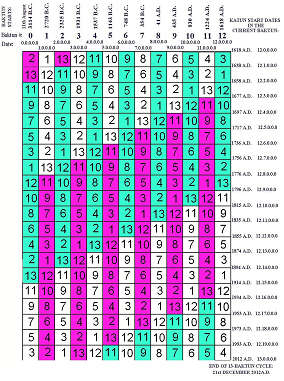
The 13-katun cycles mapped onto the 13-baktun cycle. Each square is a katun, each column is a baktun. Note the 13-katun cycles (that start with an 11 Ahau katun), end on a 13 Ahau katun, while the final katun of the 13-baktun cycle is a 4 Ahau katun
In the 13-katun cycle, each katun was named after the final day of the katun in the Tzolkin (260-day) calendar. The cycle started on Katun 11 Ahau and ended on Katun 13 Ahau (see diagram). Makemson realized that this statement didn't fit with the facts, since it says the bundle of 13 katuns was tied up – meaning the cycle ended – on 4 Ahau. However, she knew that the 13-baktun cycle ended on katun 4 Ahau. (the final day is a 4 Ahau day). Although Makemson had developed her own correlation, which has since been discounted, this observation remains valid…so the prophecy was originally about the end of the thirteenth baktun in 2012. It seems that when the 13-baktun cycle fell out of use in the early tenth century, some of the prophecies were retained and reapplied to the 13-katun cycle.
Just before the prophecy mentioned above, we find this:
"The Nine shall arise in sorrow, alas…And when over the dark sea I shall be lifted up in a chalice of fire, to that generation there will come the day of withered fruit. There will be rain. The face of the sun shall be extinguished because of the great tempest….Presently Baktun 13 shall come sailing,…. Then the god will come to visit his little ones. Perhaps "After Death" will be the subject of his discourse." (Tizimin p.15-16)
Here, Makemson has rendered Katun 13 as Baktun 13, for the reasons just explained. As you can see, these prophecies predict climate change, UFO appearances, crop failure, darkness and a return of the gods – nine gods – for the end of the current era in 2012. They also support the Tortuguero prophecy, which predicted darkness and a return of the nine gods. However, it isn't all bad news, since the prophecy concludes with:
"Then finally the ornaments will descend in heaps. There will be good gifts for one and all, as well as lands, from the Great Spirit, wherever they shall settle down."
As for the phrase, "After Death" will be the subject of his discourse, I have explained elsewhere that the possibility that a significant excursion of the geomagnetic field in response to an influx of solar and interstellar plasma, could trigger the pineal magnetite to cause an internal secretion of pineal hallucinogens (at least five – three beta-carboline molecules and two methylated trypatamines, including DMT are manufactured in the pineal gland). In other words, since Rick Strassman's study has shown that internal DMT is produced at birth, death, and during mystical experiences, it seems possible that one interpretation of this phrase is a mass near-death experience for humanity.
THE NINE NIGHT LORDS
At Tikal is the nine-leveled Pyramid of the Giant Jaguar, and according to Bob Makransky, [16] Tikal was the "home of the Bolontiku", where they have their own temple (in Complex Q), with nine altars in front of it. At Palenque, in the base of the nine-levelled Pyramid of Inscriptions, is the tomb of Lord Pacal, and the walls show nine deities, that are thought to be the Bolon Ti Ku or Nine Night Lords. This suggests that the nine levels represent the nine levels of Xibalba. The Nine Night Lords were, like God L and Bolon Yokte, present at the last Creation, and associated with the underworld – Xibalba. In the Chilam Balam books, it is stated that the Bolon Ti Ku defeated the Thirteen Heaven Gods. To understand the meaning of this, we can take a trip round the world to find a common thread throughout ancient mythology, but first we can take a clue from the Popol Vuh myth.
The Popol Vuh says that two gods, Hun Hunahpú (an alias of the Maize god and solar deity) and Vucub Hunahpú are summoned to the underworld to play a ball game with the Lords of Death (there are seven of them). They are killed and Hun Hunahpú's head is hung in a tree. Later, Hun Hunahpú's sons – Hunahpu and Xbalanque – descend to Xibalba and are tested in six zones of fear: the bat house, the razor house, the dark house, the jaguar house, the fire house and the cold house. They outwit the Lords of Death and become immortal, ascending to the sky as constellations. In summary, they descended to the underworld, conquered their fears and metamorphosed to an immortal state.
In Greek myth, Dionysus descended into Hades to rescue his mother, who he placed in the stars; in Christianity, Jesus descended into hell, and resurrected after three days, then ascended into Heaven; in Mithraism, Mithras dies at the winter solstice and is reborn after three days (solar standtill) – he waits in Heaven for the End of Time, when he will return to the Earth to awaken the dead and pass judgement.
YGGDRASIL AND RAGNAROK
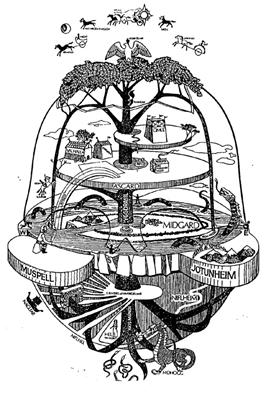
Yggdrasil and the nine realms
In Norse mythology, the Creator, Gothar, gave birth to nine gods, and their diagram of the Cosmos is called Yggdrasil, which is a version of the World Tree – an interpretation of reality that is common to shamanic cultures all over the world. They usually comprise 3 realms – an Overworld, Underworld, and Everyday world in the centre. Yggdrasil is a giant tree that is surrounded by nine worlds. The lowest of these is Helheim, the domain of the dead, ruled by Hel. Midgard is the middle-Earth realm, of Humankind, and just above it is Asgard, the realm of the Aesir, or principal Gods, led by Odin. Odin is said to have sacrificed himself by hanging upside down on the World Tree for nine days and nights in order to obtain eighteen runes (2 x 9) from the Well of Wyrd. The other realms are Niflheim, the frosty realm of ice; Jotunheim, the land of Giants; Nidavellir, the land of Dwarfs; Svartalfheim, the domain of the Dark Elves; Alfheim, the land of the Light Elves, and Vanaheim, the world of the Vanir, or fertility gods. Valhalla, the paradise for heroic warriors is part of Asgard, and the nine Valkyries are goddesses who lead the brave heroes there.
Norse mythology also has its end of time – Ragnarok – the Twilight of the Gods, when Heimdal, born of nine sister-mothers, will blow the Gjallarhorn and the world will be engulfed in flame; the giant wolf-gods, Fenris and Loki will break free, devour the Sun and kill Odin; Thor will kill the World-Serpent but will die from its poison. There will be some survivors, including nine of the gods.
This Norse mythology was, of course, the basis for Tolkien's Lord of the Rings, (as Vincent Bridges has pointed out), which was set at the end of the third age. The nine ringwraiths, or Nazgûl were nine kings who were corrupted by the nine rings of power, and were immortal in the "realm of shadows". The fourth age began with the passing of the One Ring that binds the nine, following a battle between good and evil, and this was the start of the age of men. A similar battle will occur at each junction of the ages, and we are now approaching the end of the fourth age. Another fictional manifestation of the underworld and nine was a film called The Ninth Gate, starring Johnny Depp, in which he has to locate all three copies of a 17th century book called The Nine Gates to the Kingdom of Shadows. The book contains nine engravings that decipher as parts of a ritual to raise the devil, but only three engravings from each book are the genuine ones, and these are all signed by Lucifer.
In Siberian shamanism, there is an overworld, middleworld and underworld that are all explored by the shamans. It is said that the overworld has nine "coats" or levels, that they call "God's bodies". [17] In the first Days of February, the Clear Tent ritual was held, which lasted for nine days. One of the two last shamans of "Taimir nganasans", Ivan Gornok, described the experience to A.A. Popov, a Soviet ethnographer. During the ritual, the shaman travels through all three worlds, and in the underworld, visits the Lake of the Nine Grandads, in which are nine hills with "horns". These are the bellies of nine brothers who are sleeping. The shaman has to travel down one of the horns (penises), thus emerging in the next coat of the lower world, where he finds nine tents where nine women sit. One of these is the "belly tent", and when inside, they find the woman has nine daughters, who will feed the visitors. This fractal repetition is reminiscent of a Russian nested doll.
In the Sierra Nevada, in Columbia, the Kogi people have survived isolated from the rest of the world for many generations. Their creation myth says that the Mother – Aluna – created a cosmos or womb with nine levels, which are the nine daughters. Eight of the nine worlds were infertile – Earth was the only fertile world. Daughter Earth was fertilized by Serankua – one of nine sons. The communal sanctuary is a hut called the Kankurua, which has a nine-level roof structure, in which they can access the nine worlds and the nine states of consciousness. The shamans of the Kogi are called Mamas, and they are chosen at birth and spend their first nine years in total darkness, learning to travel in Aluna, which is comparable to the astral realm of western esoteric systems.
SHAMBHALA AND THE KALACHAKRA PROPHECY
In Tibetan Buddhism, there are traditionally said to be six Bardos, or "transitional states" that are experienced between death and rebirth. However, they can apply to any transitional experience in life. These six states of consciousness are Birth, Dreams, Meditation, Death, Clear-light Experience and Transmigration. The Clear-light Experience Bardo starts with profound peace and awareness, but can include karmically-created terrifying hallucinations including meetings with 42 peaceful and 58 wrathful deities. Those who are not spiritually prepared (by meditation, and reading the Bardo Thodol, or Tibetan Book of the Dead, with its exercises), could end up transmigrating into a "less than desirable incarnation". In the Dzogchen teaching of the Nyingma school of Vajrayana Buddhism, it is said that there are nine Bardos – the three extra ones are Vision, Movement, and Instantaneous Ordinariness. The nine Bardos are connected with the nine Yanas, or paths of Buddhism, and are symbolised in the "nine-pronged dorje and drilbu" – ceremonial tools representing compassion and wisdom. Remember that when Bolon Yokte returns at the end of the 13th Baktun, the Chilam Balam indicated, "After Death will be the subject of his discourse."
There is a mythological hidden kingdom in Tibet called Shambhala. Many have searched in vain for this land of Paradise. Edwin Bernbaum's book, The Way to Shambhala is probably the best overall guide, and he says that there were 2 dynasties of kings of Shambhala – the eighth king of the first dynasty founded a new dynasty of which he was the first of 25 kings that would each rule for 100 years. The Kalachakra prophecy says there would be a total of 32 kings between the time of Buddha's death and the coming of the Golden Age, which will last at least 1,000 years, when there will be no more toil or conflict, and the human lifespan will expand to 1,800 years. Some lamas say that this king – Rudra Cakrin, (the Hindu name is Kalki) is now ruling, since there are disputes over the date of Buddha's death.
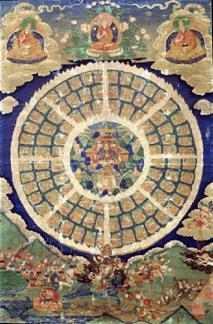
A map of the kingdom of Shambhala, with the eight outer and the ninth inner region separated by mountain ranges.
Shambala is shaped like an eight-petalled lotus flower. There are eight regions surrounding a ninth. Each of the eight regions has 12 principalities, but in the centre of the heart of the lotus is the Central Palace, which has nine levels. This is also referred to as Mount Meru, the axis mundi. Shambhala is said to be the Heart Chakra of the world, and the heart chakra or Anahata is usually depicted as a 12-petalled flower, but sometimes it has eight (there is an extra chakra in Tibetan Tantra called the Hrit chakra, that is just below the Anahata, and it has eight petals). There are several guidebooks to finding Shambhala, but Bernbaum says [18] these have a symbolic meaning:
"In other words, we can read the guidebooks to Shambhala as instructions to taking an inner journey from the familiar world of the surface consciousness through the wilds of the subconscious to the superconsciousness. From this point of view, the deities, demons, mountains, rivers and deserts described by the texts, symbolise the various contents of the unconscious that we have to face and master – or make use of – on the way to awakening the innermost mind. These contents include a number of inner obstacles or psychological blocks of two general kinds. Some come from repressed parts of the surface consciousness: They include hidden fears, desires, illusions, and habits that keep us confined to our usual state of limited awareness. Others have their source in elements of the deeper levels of the mind that act as barriers to keep the superconscious from being overrun by the impure and chaotic contents of the subconscious."
According to Victoria LePage, [19] the eight outer regions of the kingdom of Shambhala represent eight states of consciousness, accompanied by pain and conflict that lead to the ninth, the "radiant mind of enlightenment". In Kundalini Yoga, it is said that when Kundlini (the evolutionary serpent-like energy that is dormant in the base chakra of un-awakened people), ascends the subtle channel of the spine (the sushumna) and reaches the Anahata chakra, then the soul awakens. Now recall that the Hopi say at the next Emergence, consciousness will reverse its direction, back from solar plexus to heart.
Rudra Cakrin will ride out and "kill the barbarians", ending the age of discord, and inaugurating the Golden Age, when Shambhala will become visible. Bernbaum says that the killing of barbarians refers to "a decisive inner conflict that results in the emergence or awakening of the innermost mind". So, the Kalachakra prophecy seems to be saying that we are on the verge of a Golden Age, and just before it emerges, people will confront their own inner demons and shadow material, clearing out the closets as a necessary preparation for life in an idealized world. The inference is also there, that realms that were previously invisible become accessible to our senses.
The Shambhala concept is rooted in the pre-Buddhist shamanic tradition of Tibet, known as Bön. The Bön equivalent of Shambala was called Olmolungring and was also a completely pure and spiritual land (usually depicted as a square with many rectangular regions, but in the centre are eight regions surrounding a central square region). At the centre was a nine-levelled mountain called Yungdrung Gutsek, and each level symbolised the nine stages of Bön that lead to enlightenment. Olmolungring was not a physical place and could not be reached before enlightenment was achieved. However, some scholars have identified the Mount Kailash area as Olmolungring – it has an obvious layered look, due to the weathering of the geological strata.
HEAVEN, HELL AND PURGATORY
In Christian tradition, there are nine choirs of angels around the throne of God: Seraphim; Cherubim; Dominions; Thrones; Principles; Potentates; Virtues; Archangels and Angels. Twenty-four centuries ago, Plato conceived of nine spheres around the Earth, that were the "ethereal spheres" of the moon, the sun, Mercury, Venus, Mars, Jupiter and Saturn, then the sphere of the fixed stars, then the sphere of the zodiac. In the second century AD, Ptolemy used the same scheme, but with the sun's sphere moved to a place between Venus and Mars. The Kabbalistic Tree of Life showed nine sephiroth or spheres above the Earth, or Malkuth. The spheres are connected by 22 paths that are related to the 22 letters of the Hebrew alphabet, the 22 trumps of the Tarot deck, and the 22 chapters of the Book of Revelation. The trumps refer to the trumpets of Revelation that announce the arrival of Judgement Day, depicted on trump number twenty.
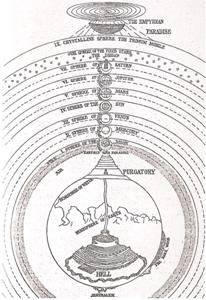
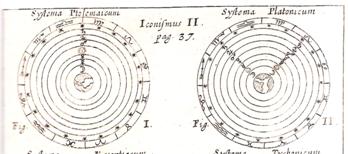
The nine spheres of Ptolemy and Plato compared with Dante's nine spheres, sevenfold (really ninfold) Purgatory and nine circles of Hell. This drawing by Cactani was not done until 1855 – over 500 years later – Hell has too many circles.
In the thirteen hundreds, Dante wrote his divine comedy, describing the "pilgrimage of the soul" up though nine circles of Hell, via the seven terraces of Mount Purgatory, and the nine spheres of the planets, stars and Primum Mobile, all of which are mobilized by the angels, to Paradise. There were later medieval variations on this theme by Lull, Fludd, Cusanus, Kircher and other philosophers.
The nine circles of Hell each hold those unrepentant sinners who are punished for their various crimes, including the seven deadly sins.
Mount Purgatory is for those who are repentant but need to be purged (cleansed) – hence Purgatory. The mountain has seven levels that relate to the seven deadly sins, but there are two extra layers that exist at the base of the mountain, making nine layers altogether – these are the late-repentant and the excommunicates. The first level deals with pride, in which souls carry a heavy burden on their back, symbolising the burden of pride; the second level dealing in envy, where the eyes are sewn shut and clothes that render one virtually invisible are worn. On the third terrace, anger is corrected by acrid smoke, showing how anger clouds judgement. On the fourth terrace, sloth, or spiritual apathy is dealt with by running continually. On the fifth level, greed is dealt with by laying face down on the ground, immobile, so that external desire turns inward. On the sixth level, gluttony is treated by abstention from food and drink, and on the seventh level, lust is corrected by a wall of flame that burns away the carnal desires. At the top of the mountain is the Garden of Eden, where the souls return to original innocence. Then the climb through the nine heavenly spheres starts, where each level is peopled by souls with different virtues, until Dante sees God as a point of light surrounded by nine rings of angels. Dante then goes beyond to a zone called the Empyrean, where the souls of believers form the petals of a rose. There are strange echoes here, of the Shambhala myth.
NINE VAULTS OF ENOCH
The 13th degree of the Scottish Rite of Freemasonry is called the Royal Arch of Enoch. [20], [21] Enoch was the great-grandfather of Noah, who is said in the Book of Genesis to have lived to the age of 365 years. The rite records Enoch built a column of granite and a column of brass, engraved with knowledge of arts and science, to survive a coming flood (the flood of Noah, Enoch's grandson). He dug nine vaults in a vertical sequence, one above the other, each roofed with an arch, and the lowest was hewn from solid rock. The crown of each arch had an aperture sealed with a square stone and iron lifting-ring, and over the top was built a roofless temple of un-hewn stones, with granite paving concealing the top entrance stone. In the lowest vault he placed a cube of agate in which was embedded a triangular plate of gold, studded with precious gems and engraved with "the ineffable name of God". Many years later, after the flood, when Solomon built his temple, he also built nine vaults, the ninth of which was under the Holy of Holies, and which was linked to his palace by a tunnel. Workmen building a Temple of Justice on the site of Enoch's temple discovered the vaults and delivered the agate cube with its triangular golden plate to Solomon, who put it into his own ninth vault below his temple. Like a Mount purgatory going downwards, one has to descend to the ninth and deepest level to achieve the prize.
In 1119, the nine original Knights Templar went to Jerusalem and set up their headquarters in the Al Aqsa mosque on Temple Mount, and spent nine years digging under the site of Solomon's Temple. It is widely thought that they found scrolls and treasure, which ended up in their Paris Temple, before being taken to Rosslyn chapel in Scotland. Rosslyn is a replica of Solomon's Temple, and is known to have at least one secret vault and a tunnel.
Several esoteric societies have a nine-level hierarchy of grades. This includes the Rosicrucians; the Theosophists; the Ordo Templi Orientis (before Aleister Crowley added more grades), and the nine initiations of the Ismaelis and the Assassins. It also includes the nine grades of the Priory of Sion, (but the Nautonnier, Pierre Plantard admitted in 1993 that the society was a hoax). The nine-level hierarchy represents increasing levels of spiritual development.
The underworld theme continues in the concept of the labyrinth. In the Cretan myth, the labyrinth was built by Daedalus to house the Minotaur – a monster that was half man and half bull. Every nine years, King Minos sacrificed seven young Athenian men and seven young Athenian women to the Minotaur. When the Greek hero Theseus volunteered as one of the seven male victims, Ariadne, the daughter of Minos, fell in love with him and gave him a ball of thread with which he could find his way out of the labyrinth, provided he would marry her afterwards. Theseus killed the Minotaur, rescuing Athens from its fate. Mythology commentators tell us that the labyrinth represents the underworld, to which the hero must descend, with the help of the maiden. Replica labyrinths usually have seven, nine, or eleven rings, representing the levels of the underworld, and the story represents the killing off of our "beast within" – repressed violence, anger and sexual obsessions, before we will be ready to integrate with our higher selves (the Overself). Note also that the Cretan labyrinth symbol represents the rebirth or Emergence into the Fifth World of the Hopi.
PRECESSION AND THE NINE DOORS OF LOUHI
In Hamlet's Mill, de Santillana and Von Dechend tell how the Danish myth of Amleth or Amlodhi concerns a mill that was turned by Nine Maids on an island off Norway, until the mill was stolen and the ship sank, causing a permanent whirlpool. In another version, the mill belongs to King Frodhi, an alias of Freyr, one of the Vanir, who, live in Vanaheim, one of the nine realms on Yggdrasil. The huge mill was worked by two giant maidens and ground out gold, peace and happiness, making a Golden Age, but it eventually broke and ground out only salt. The Kalavala epic of Finland tells a similar story about a smith called Ilmarinen, who is tricked by Vainamionen, the minstrel, into going to the frozen land of the North, where he has to forge the Sampo, a magic triangular mill that grinds out flour, salt and money, in exchange for the daughter of Louhi, the wicked Queen of the frozen land. When it is finished, Louhi entombs it in a cave in the Copper Mountain, behind nine doors of granite, each sealed by nine locks. The Sampo is called "the treasure". Ilmarinen does not win the maiden, however. Eventually, the minstrel and smith go back to the frozen North, and open the nine doors by magic, then steal the Sampo, and Louhi chases them across the sea, but the mill eventually breaks and falls into the sea.
The mill tree was also the world axis, and the Golden Age comes and goes according to the shifting of it, which is the precession of the equinoxes. Nine is connected to the precession cycle, since the precessional numbers 72, 108, 216, 432, 25,920 all add to nine.
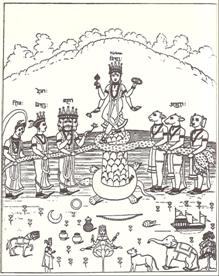
The Churning of the Milky Ocean from the Maharabata, using the seven or nine-headed snake, encodes precession.
In the Hindu Mahabharata and Ramayana texts, the Churning of the Milky Ocean represents precession, according to de Santillana and Von Dechend, and is caused by a tug-o-war between two dynasties of gods, who are turning the pole by pulling on a snake that is wrapped around it. The snake usually has seven or nine heads – both forms are depicted at the Angkor Wat temple complex in Cambodia.
The stone circles and other megalithic sites found across Britain are known to have functioned as Neolithic calendars. Many have alignments to Equinoxes and solstices, or lunar standstills. From some of these observatories, the change in the rise and set positions of stars caused by precession would have been observable. At Avebury, for example, Robin Heath has shown that the line of hills to the East provided a horizon on which precession of half a degree would be clearly evident after 36 years observation, as rising stars moved between trees on the skyline. Many stone circles are named after nine maidens – in fact, all the stone circles in Cornwall are locally referred to as the nine maidens, regardless of the number of stones or other names for the sites. There are also the Nine Ladies circle on Stanton Moor and Nine Stones Close, both in Derbyshire, and there are several Wells of Nine Maidens in Scotland.
So the number nine is universally associated not only with the underworld, the overworld, altered states of consciousness, but also with precession, ancient calendars and maidens – in fact, nine is the number of the Goddess according to mythologist Joseph Campbell. [22]
NINE GODDESSES
The Goddess has a triple aspect: Maid, Mother and Crone. These relate to waxing moon, full moon and waning moon. The threefold aspect multiplies to a ninefold aspect that relates to the nine months of gestation. One of the best known groups of nine goddesses is the Nine Muses, who were Greek Goddesses that provided inspiration in the arts and sciences, and are said to have inspired Pythagoras, who conceived of the Tetractys – a triangular arrangement of nine points around the bindu, or seed – a diagram that relates to octaves and other ratios in music. The Muses were associated with the Oracle at Delphi.
In Arthurian legend, Arthur was taken to the Isle of Avalon (the Otherworld) to have his wound healed by nine sisters, one of whom was Morgan le Fay. A Roman historian records such an island – the island of Sein (breast), off Brittany, occupied by nine priestesses, who were healers, could predict the future, control winds and waves and change into animal shapes. A similar island – Annwn (the Underworld) is described in a Welsh epic in which is Cerridwen's Cauldron, tended by nine virgins, who "boiled the cauldron with their breath". The cauldron had a ring of pearls round its rim, it produced an elixir that conferred inspiration, and oracular speech came out of it. King Arthur entered the Underworld (Annwn) to steal the cauldron.
In the Earthly counterpart of Avalon, Glastonbury, the archaeologist Bligh Bond, was appointed by the Church of England as director of excavations at Glastonbury Abbey. Bond enlisted the help of a psychic who brought through the spirits of nine dead monks who called themselves the Company of Nine, or the Nine Elect. They told him where to find the Grave of Arthur and the lost Edgar chapel, and a grave and chapel were duly dug up just where they said. When the Church authorities found out, Bond lost his job at the Abbey, but the episode reinforces the connection between the Underworld (Avalon and the world of the dead) and number nine.
The harmonic vision of Martianus Capella, a 5th-century neo-Pythagorean, assigned the nine spheres around the Earth to the nine muses, with a three-headed snake connecting Heaven to Earth, as illustrated in Kircher’s diagram below. The mythologist Joseph Campbell says the snake correlates to Kundalini, the Hindu fire snake that lies dormant in the base chakra, Campbell says the Earth represents the base chakra, so the Earth and the next two spheres are equivalent to the bottom three chakras; the next three muses/spheres represent the Heart chakra, and the top three Muses/spheres (excluding Heaven) represent the top three chakras. Kundalini's full title is Kundalini Shakti – the Earth goddess, who comes up from the ground and when awakened, rises up the spine, energising the chakras until she meets Shiva, her male consort, who descends from above, and they meet in the Crown chakra, annihilating the ego in a trance called Samadhi. At the Navatri Festival in India, nine forms of the goddess Shakti are worshipped for nine days. The first three days are a purge, and the first goddess encountered is Durga, who "destroys our impurities and defects". The second group of three days centres around wealth, and the last three on success.
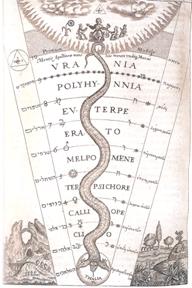
Anastasius Kircher’s drawing (Ars magna lucis, Rome, 1665) connecting the nine Muses to the nine heavenly spheres, that relate to the chakras, connected by Kundalini.
It is now known, due to John Major Jenkins' discoveries, revealed in his book, Pyramid of Fire (2004) [23] , that the Toltecs, who worshipped Questzalcoatl, the feathered serpent god (Kukulcan to the Maya) regarded Quetzalcoatl in a similar way to Kundalini – a serpentine evolutionary energy that climbed up the spine. There is a prophecy from the Chilam Balam of Chumayel that says Kukulcan will return in Katun 4 Ahau, and the current katun is katun 4 Ahau, from 1993 to 2012, so this suggests the descent of Bolon Yokte could be associated with a mass Kundalini awakening.
THE ENNEAD OF HELIOPOLIS
Egypt had several enneads, or pesedjets (nine-god groups), to use the original Egyptian term, rather than the Greek. The most important was the Ennead of Heliopolis, (or pesedjet of Annu or On), that consisted of Ra-Atum, the creator, who self-begat Shu and Tefnut, the air and moisture gods, respectively. Shu and Tefnut were the parents of Geb and Nut, the Earth and Sky. Geb and Nut were (like the Maori Sky and Earth gods Rangi and Papa), in a close embrace, and produced children before separating. The offspring were Osiris, Isis, Set and Nephthys. All these gods are associated with the Underworld, or Duat, which is really the region between the Earthly and spiritual worlds, according to Jeremy Naydler. Atum-Ra travelled each night through the Duat. Shu was the division between the living world and underworld and he protected Ra on his journey through the Duat by using magic spells to ward off Ra's enemy, the snake-demon Apep. The pyramid texts suggest that Tefnut was the atmosphere of the Duat. Geb was sometimes seen as god of the underworld, and protector of the dead; Nut contains the Duat as part of her body. Osiris was the god of the dead, resurrection and judgement, and Isis as his wife was thus Queen of the Duat. Set protected Ra on his nightly journey through the Duat, and Nephthys, the helper of the dead, also accompanied Ra and Set on the boat.
In the Book of Coming Forth by Day (known as the Egyptian Book of the Dead), nine human components are described. They are the khat, or physical body; the ka, or double, which is equivalent to the etheric body; the ba, or heart-soul, equivalent to the astral body, and symbolised by a bird with a human head; the akh or khu, (spirit-soul), which is a divinised ba; the sahu, or spiritual body, which carries the akh; the khaibit, or shadow; the sekhem, or vital power; the ren, or name, and the ab, or heart.
Jeremy Naydler has done a great job of decoding this Egyptian soul-science ("psyche-ology"). [24] The Osirian initiation was centred on achieving the experience of the ba, where consciousness is externalised into the astral body and the physical body can be observed from another viewpoint. However, the next stage in the process was to neutralize the khaibit, symbolised by a dark human silhouette, since it represents "all the untransformed Earthly appetites and obsessions that fetter the ba to the physical realm and prevent it from moving on". The divinization of the ba creates the akh or khu ("shining one" or "illuminated one"), symbolized by another bird – the crested ibis. It is also called "the imperishable one" that returns to its source beyond the Duat. In order for the akh to be released from the body, a new spiritual body had to be germinated from the physical body as a vehicle for the akh. This spiritual body is the sahu. This sounds like the immortal man in Taoist yoga that is gestated in the abdomen and expelled through a psychic opening in the top of the head to appear as a person sitting on a lotus within a golden sphere.
When Robert Monroe found himself floating outside his body in the nineteen fifties, he thought he was going mad, until his doctor told him that the experience was not uncommon, but people just didn't like talking about it. Monroe had been listening to subliminal learning tapes while he was asleep at the time he had the experience, so he tried to replicate it by experimenting with sound. He discovered that the brain could be entrained into producing theta waves while awake using binaural beats, where the difference between frequencies heard in each ear is the required frequency – in this case, around 4Hz. He set up The Monroe Institute – a charitable binaural research and education facility in Virginia, to explore the phenomenon.
In Far Journeys, Monroe describes the results of thirty years of exploration of the astral realms. The first realm experienced by those leaving their bodies is the Physical World – identical to everyday life, but with extra inhabitants – the souls of the recently dead, and those who are unaware that they have passed on, plus the dreaming bodies of those who are asleep and dreaming. Next is the Innermost Ring; then the Waiting Ring; then the Major Ring, which is split into four quarters – the Inner; Lower; Upper and Outer; then the Outermost Ring, and beyond that Graduation. This adds up to nine astral realms. Personal development allows the soul to climb the rings until they make it to Graduation, after which no more Earthy incarnations are necessary.
NINE STEPS TO TRANSFORMATION
In Mercurius, [25] Patrick Harpur says that the aim of the alchemists was to restore man's unity with Nature and to heal the rift between Heaven and Earth that had been caused by the Fall. They tried to reinstate the Golden Age by reproducing the operations taught to man by Hermes Trismegistus. He explains that in tribal societies, "when people are profoundly subject to physiological processes", such as puberty or pregnancy, they have to be "cooked" in an oven. This symbolic cooking is a rite of passage, and "some Amerindian tribes place pubescent girls and women who have just given birth into 'ovens' hollowed out of the ground…". The Hermetic vessel, he says, is "analogous to the ritual tomb, or womb, or oven in which rites of passage take place", and the physical changes inside it "are symbolically correlated with the spiritual changes of the alchemist". The Magnum Opus, or Great Work of the alchemists incorporates all the rites of passage, according to Harpur:
"Solution = the birth of Sol; Separation = his initiation at the hands of hitherto unconscious desires and effects such as occur at puberty; Conjunction = marriage (and death in the forbidden union between Sol and his mother/sister/daughter Luna); Putrefaction = burial (a mixture of cremation and burial, perhaps -cooked: rotting: cremation: burial); Congelation = rebirth (the same configuration as solution/birth but transformed to a new spiritual status); Sublimation (Rubedo) = ? Some state for which nature supplies no equivalent. The Opus re-enacts one's whole life in a short (or shorter) space of time in order to raise it up into consciousness and recreate it". [26]
There are usually said to be seven stages of alchemy. Harpur gives eight; Michael Maier, a sixteenth century Rosicrucian alchemist described nine stages of "involutive-evolutive transmutation of the threefold body of the human being, the threefold soul, and the threefold spirit".
At the end of the 13-baktun cycle, the Sun will be reborn as One Hunahpu according to Maya mythology. Perhaps this could be a macroscopic alchemical initiation for the Earth: the rebirth of Sol. Could this be when we find out what rite of passage is represented by Sublimation? In chemistry, sublimation is "the transition from a solid to a gas, with no intermediate liquid stage". Here we may have a clue.
In the spiritual alchemical process of Taoist Yoga, there are nine impediments to the Vital Breath that allows restoration and circulation of the generative force. These are called "The Nine unsettled breaths", and they are "caused by anger which lifts and fear which lowers the breath; by joy which slows it down; by grief which disperses it; by terror which throws it out of gear; by thinking which ties it up; by toil which wastes it; by cold which collects and heat which scatters it." The generative force is collected in the lower tan t'ien centre (just below the navel), where it is purified. Then it is raised to the middle tan t'ien at the solar plexus, where it is "transmuted into vitality". After this it is sent to the upper tan t'ien (pineal area), where vitality is transmuted into spirit. Each of these centres is called a cauldron, but when the upper tan t'ien takes over, it is called the precious cauldron. [27]
Charles Muses has described a nine-step ritual movement called he Pace of Yu, [28] which relates to the nine components of hexagram 63 of the I Ching (three yang lines and six yin semi-lines). Hexagram 63 is, surprisingly the climax of the series, rather than hexagram 64. It means "climax and after; equilibrium achieved". It is an encoded form of transmitting knowledge of the "nine cauldrons of transformation" in which are brewed nine ingredients for the elixir of immortality. These are called the "nine numinous jewels". The cauldrons are also called the "nine cranial palaces" that resonate to the seven (plus two hidden) stars of Ursa Major. Muses says the process is governed by the Goddess, so again, we have nine, the Goddess and the cauldron as a key to transformation to a higher state. The process describes a sacred pregnancy – the germination and nurture of an embryonic immortalised self.
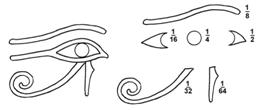
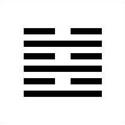
Hexagram 63 of the I Ching and its nine parts that correlate to the Pace of Yu, and the Eye of Horus with its fracional components that give 63/64
Muses says hexagram 63 means "journeying across the great stream of time and death into a region of harmony". This reminds us of what the Bolon Yokte have in store for us upon their "descent" in 2012 – their discourse will be on the after death state. Since, like the Taoists, the Egyptians also had a "soulcraft" technology, this idea complex may be associated with the Eye of Horus, as the various components of it were hieroglyphs for measuring volume and time. They add to 63/64, and there is one myth in which Horus gave his eye to Osiris to help him rule in the netherworld.
Alberto Villoldo has recently announced that he is giving a series of nine Peruvian initiations or rites called the Munay-Ki. [29] They are "nine healing gates" that allow a conquering of fear and a ""clearing of psychic sludge left by past traumas" in order to transform the energy field and communicate with Luminous Beings and to allow aspirants to start the process of change towards becoming Homo luminous. The rites are said to be specially to prepare for 2012, when the Andean priests, or Paqos of the Qero people – direct descendants of the Incas – say that Taripay Pacha will start – the "Age of Meeting Ourselves Again", according to Juan Nunez del Prado. When the three worlds – hanaq pacha, kay pacha and ukhu pacha (overworld, middleworld and underworld) will converge. Villoldo is the only source on the Munay-Ki, so I don't know how genuine it is. However, it does seem a very good fit for the pattern that we have revealed here.
HEALING AND REVEALING THE GOD-SELF
The Maya myths tell of a descent of heroes to an underworld of six houses to conquer the Lords of Death and to conquer their own fears, but other Maya myths mention an underworld of nine levels, that relate to the Nine Lords of the Night. The latest studies by Maya epigraphers indicate that these Night Lords are the same as the God of Nine Steps (Bolon Yokte) who is set to descend at the next Creation in 2012, and that these nine gods relate to the germination phases of maize, human individuals and the human species evolutionary quantum leap. We have seen that all across the world, the number nine is associated with the underworld, and trips into the underworld to confront what turn out to be our own demons, then trips upward to heaven in a pilgrimage of the soul towards an enlightened state.
The various myths around the number nine seem to boil down to three main themes:
1. Healing the Wounded King: A descent to the Underworld of Nine levels; a confrontation with inner violence, rage, fear; at the deepest level, a divine connection is regained, leading to healing and rejuvenation.
2. Ascent to the Ninth Heaven: Consciousness rises through Nine spheres; Shiva and Shakti unite; the Goddess returns leading to a whole-mind integration of right and left brains.
3. Cyclic Return of the Gods: A Golden Age will return, governed by precession: circa 2012, our inner cauldrons will be activated along with the germination process of a subtle body that can survive in a post-mortem state.
In other words, to put it in a nutshell, in 2012, or thereabouts, according to the evidence presented here, something will trigger a confrontation with our shadow selves at a time of social and environmental upheaval; the Kundalini evolutionary energy will be awakened; there will be an integration of sub-personalities as we enter an enlightened state, accompanied by expanded perceptions, the generation of a plasma body, and contact beyond the physical spectrum. Then the Golden Age will begin….
GEOFF STRAY Bio page on website: http://www.diagnosis2012.co.uk/geo.html
Sven Gronemeyer's homepage: http://www.sven-gronemeyer.de/index.html
REFERENCES
- Dave Stuart's quick translation of Monument 6: http://groups.google.com/group/utmesoamerica/browse_thread/thread/2ad64b039cb60983/0396cfd4957fd61e#0396cfd4957fd61e. [back to text]
- Sven Gronemeyer's Tortuguero thesis part 1: http://www.wayeb.org/download/theses/gronemeyer_2004_1.pdf. [back to text]
- Sven Gronemeyer's Tortuguero thesis part 2: http://www.wayeb.org/download/theses/gronemeyer_2004_2.pdf. [back to text]
- Sven Gronemeyer: "The Maya Site of Tortuguero, Tabasco, Mexico: Its History and Inscriptions"; in Acta Mesoamericana Vol. 17, Verlag Anto Saurwein; Markt Schwabe, Germany, 2006.. [back to text]
- John Major Jenkins' Bolon Yokte page: http://alignment2012.com/bolon-yokte.html. [back to text]
- Eberl, Markus; and Christian Prager (2005). "B'olon Yokte' K'uh. Maya conceptions of war, conflict, and the underworld.". in Peter Eeckhout and Geneviève Le Fort (eds.). Wars and conflicts in prehispanic Mesoamerica and the Andes: selected proceedings of the conference organized by the Société des Américanistes de Belgique with the collaboration of Wayeb (European Association of Mayanists), Brussels, 16-17 November 2002. British Archaeological ReportsInternational Series, no. 1385. Oxford, UK: John and Erika Hedges Ltd. pp. 28-36. [back to text]
- Dave Stuart's more complete Monument 6 translation http://www.famsi.org/mailman/htdig/aztlan/2006-August/002533.html. [back to text]
- Palenque and pibnaahs: http://learningobjects.wesleyan.edu/palenque/structures/temple_xiv/. [back to text]
- Michael Grofe's thesis on Precession in the Dresden Codex: http://proquest.umi.com/pqdlink?did=1407490561&Fmt=2&VType=PQD&VInst=PROD&RQT=309&VName=PQD&TS=1201138293&clientId=79356&cfc=1. [back to text]
- Barb MacLeod's work: http://alignment2012.com/3-11PikFormula.html. [back to text]
- 2012 Tribe discussion: http://2012.tribe.net/thread/b932bc9b-4c58-4233-8e61-331b1d52b943. [back to text]
- John Major Jenkins: The 2012 Story: The Myths, Fallacies and Truth Behind the Most Intriguing Date in History, Jeremy P.Tarcher/Penguin, New York, 2009, pp.263-277. [back to text]
- Michael Grofe's essay The Name of God L: B'olon Yokte' K'uh? http://www.wayeb.org/notes/wayeb_notes0030.pdf. [back to text]
- Sven Gronemeyer: Glyphs g and f as aspects of the maize god http://www.wayeb.org/notes/wayeb_notes0022.pdf. [back to text]
- Maud Worcester Makemson: The Book of the Jaguar Priest – A Translation of the Book of Chilam Balam of Tizimin, With Commentary. New York. Henry Schuman, 1951. [back to text]
- Bob Makransky and the nine altars at Tikal http://www.dearbrutus.com/tikal_and_the_nine_mayan_gods.html. [back to text]
- Siberian shamanism: http://www.shalagram.ru/knowledge/mysticcosmos/mystic_cosmos_chapter6.htm. [back to text]
- Edwin Bernbaum: The Way to Shambhala: A Search for the Mythical Kingdom Beyond the Himalayas; Shambhala Publications, Inc., Boston, Massachusetts, 2001. P.207; P.245. [back to text]
- Victoria LePage: Shambhala: The Fascinating Truth Behind the Myth of Shangri-la, Quest Books, U.S. 1996, p.33. [back to text]
- Royal Arch of Enoch http://www.brad.ac.uk/webofhiram/?section=ancient_accepted&page=ArchofEnoch.html. [back to text]
- Nine Vaults of Solomon http://www.brad.ac.uk/webofhiram/?section=ancient_accepted&page=14Grandelectmason.html. [back to text]
- Joseph Campbell: The Mystery Number of the Goddess, in In All Her Names – Explorations of the Feminine in Divinity, Harper San Francisco, New York, 1991. [back to text]
- John Major Jenkins: Pyramid of Fire: The Lost Aztec Codex: Spiritual Ascent at the End of Time;.Bear & Co. Rochester, Vermont, 2004.. [back to text]
- Jeremy Naydler: The Temple of the Cosmos, Inner Traditions International, Rochester, Vermont, 1996, p.9; pp.193-212. [back to text]
- Patrick Harpur: Mercurius: The Marriage of Heaven and Earth; Blue Angel Gallery, Australia, 2007.. [back to text]
- Ibid. pp. 247-248. [back to text]
- Charles Luk: Taoist Yoga; Rider (Random House), London, 1970, 1996; p.218. [back to text]
- Charles Musès: The Ageless Way of Goddess in In All Her Names – Explorations of the Feminine in Divinity, Harper San Francisco, New York, 1991. [back to text]
- Munay Ki http://www.munay-ki.org. [back to text]









